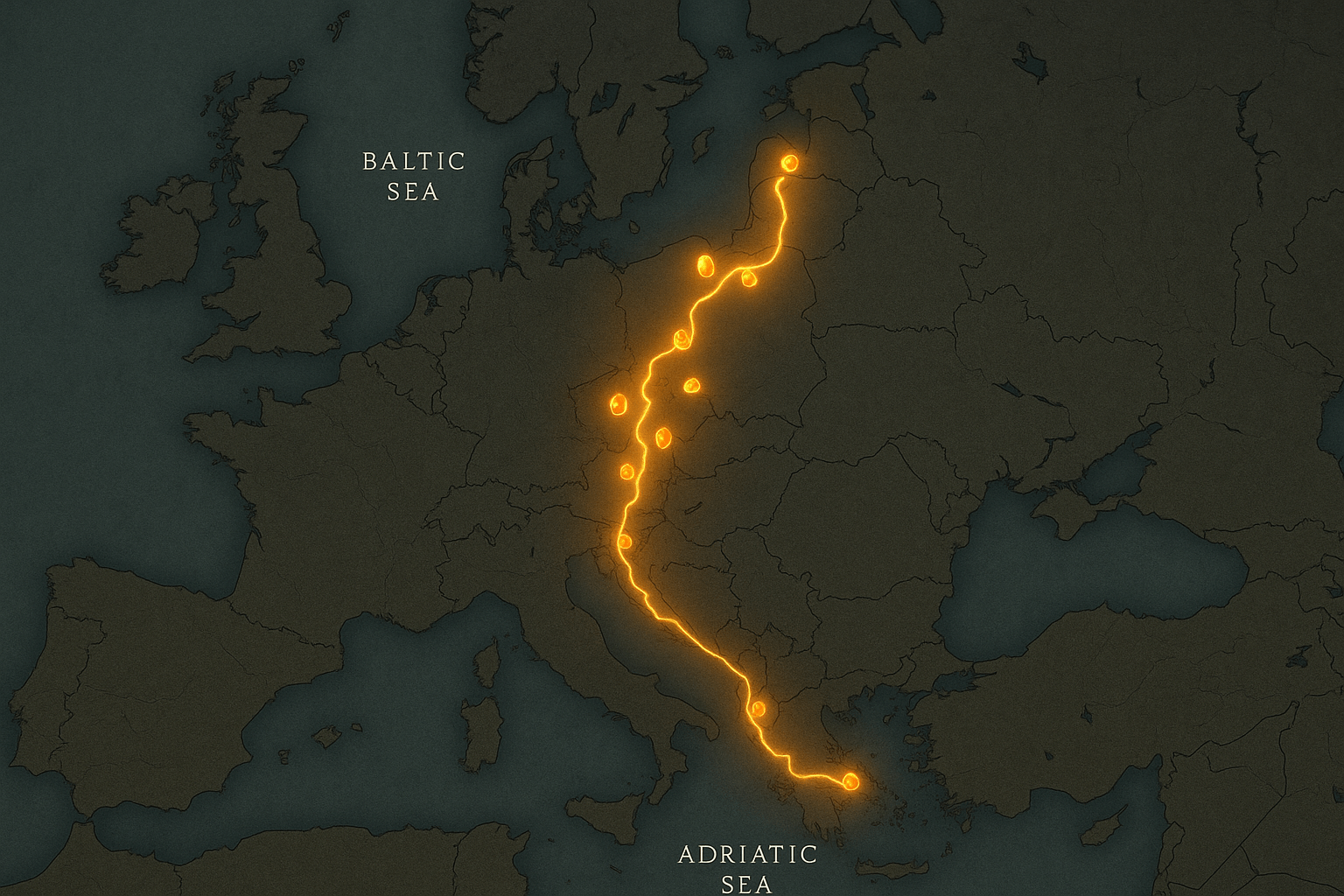The Source: Gold of the North
The story of the Amber Road begins on the dramatic, windswept coasts of the Baltic Sea. This isn’t a story of mines and quarries, but of storms and tides. Baltic amber, or succinite, is not a stone but the fossilized resin of ancient coniferous forests that flourished in the region 40 to 60 million years ago. Over millennia, geological processes submerged these forests, and the resin hardened into the golden, translucent “gemstone” we know today.
The primary source was, and still is, the Sambian Peninsula, a small piece of land that is today part of Russia’s Kaliningrad Oblast, jutting out into the Baltic. Here, and along the coasts of modern-day Poland, Lithuania, and Latvia, amber is a gift from the sea. After powerful storms churn the seabed, this remarkably low-density fossil—light enough to float in saltwater—washes ashore. Early coastal dwellers, whom the Roman historian Tacitus called the Aesti, would comb the beaches for these “tears of the gods.” They were the first link in a chain that would stretch for thousands of kilometers.
The Arteries of Europe: Tracing the Main Routes
The Amber Road was not a single, paved highway like a Roman road. It was a fluid network of interconnected paths, primarily following Europe’s great river systems—the continent’s natural transportation corridors. Traders would travel by dugout canoe, on foot, or with pack animals, navigating a complex and often dangerous landscape. While countless local paths existed, archaeologists have identified three primary long-distance routes.
The Vistula-Danube Route: The Main Artery
The most heavily trafficked and well-documented route began on the Baltic coast near the mouth of the Vistula River (in modern Poland). From here, traders would follow the Vistula upstream, deep into the heart of Central Europe. The journey’s most critical geographical feature was the Moravian Gate, a low-lying pass in the Czech Republic. This natural valley, separating the Carpathian Mountains to the east from the Sudetes Mountains to the west, served as a crucial chokepoint and a natural funnel for north-south movement for millennia. Once through the gate, traders could reach the Danube River, Europe’s grand east-west artery. Following the Danube downstream would lead them to major Celtic and later Roman settlements like Carnuntum (near modern Vienna, Austria), a bustling military and commercial hub.
The Elbe Route: The Western Path
A secondary route began further west, on the shores of the North Sea and the Jutland Peninsula (modern Denmark). From here, the path followed the Elbe River south, then connected to the Saale River. This route led traders toward the formidable barrier of the Alps. To cross them, they utilized one of history’s most famous mountain passes: the Brenner Pass. This relatively low-altitude pass provided a direct, albeit challenging, gateway into the Italian peninsula, the heartland of Roman power.
The Dnieper Route: The Eastern Connection
A third, more easterly route connected the Baltic world with Greece and the Black Sea. This path followed the great rivers of Eastern Europe, such as the Dnieper or the Dniester, south through the territories of modern-day Belarus and Ukraine. This journey traversed immense geographical features like the Pripet Marshes, one of Europe’s largest wetlands. Reaching the Black Sea, the amber could then be shipped by sea to Greek colonies and, eventually, the eastern provinces of the Roman Empire. This route is evidenced by finds of Baltic amber in Mycenaean Greek tombs, dating back to 1600 BCE, and even, it is believed, in the tomb of the Egyptian pharaoh Tutankhamun.
Navigating the Landscape: Challenges and Oases
The journey along the Amber Road was fraught with peril, dictated entirely by the physical and human geography of the time. Rivers were highways, but they could also be deadly, with seasonal floods, impassable rapids, and frozen waters in winter. Vast, primeval forests, like the Hercynian Forest described by Julius Caesar, were home to wild beasts and potentially hostile tribes.
The human geography was just as complex. The routes passed through the lands of countless different peoples—Baltic tribes, Germanic peoples, Celts, and Illyrians. Trade was a delicate dance of diplomacy, tribute, and exchange. A “toll” might be paid to a local chieftain not in coin, but in goods, for safe passage through his territory. Archaeological sites along the routes reveal the nature of this exchange. In return for raw amber, northern peoples received Mediterranean luxuries:
- Bronze and iron weaponry
- Intricate glass beads and vessels
- Roman wine transported in amphorae
- Pottery and coins
These items, found in graves thousands of kilometers from their origin, are the physical proof of the Amber Road’s reach.
The Destination: Aquileia, Rome’s Amber Capital
For most amber traveling south, the final destination was Aquileia. Founded by the Romans in 181 BCE, its location was a stroke of geographical genius. Situated at the northernmost point of the Adriatic Sea, it was the perfect terminus for the overland Alpine routes. Here, the raw amber that had survived its long journey was brought into sophisticated workshops. Roman artisans, prized for their skill, would cut, carve, and polish the “northern gold” into exquisite jewelry, amulets, figurines, and decorative inlays for furniture. From the bustling port of Aquileia, these finished luxury goods were shipped throughout the Roman Empire, gracing the villas of senators in Rome and nobles in distant provinces.
The Amber Road was more than a simple trade route for a pretty gemstone. It was a lifeline that connected disparate cultures and geographies. It moved technology (like metalworking) north and brought a piece of the mysterious, mythical north south. It was a network that shaped settlement patterns, created centers of power along its path, and fostered a shared European identity long before the concept of “Europe” even existed. It stands as a powerful testament to humanity’s ancient drive to connect, to trade, and to traverse the very geography of our world in pursuit of something beautiful.
